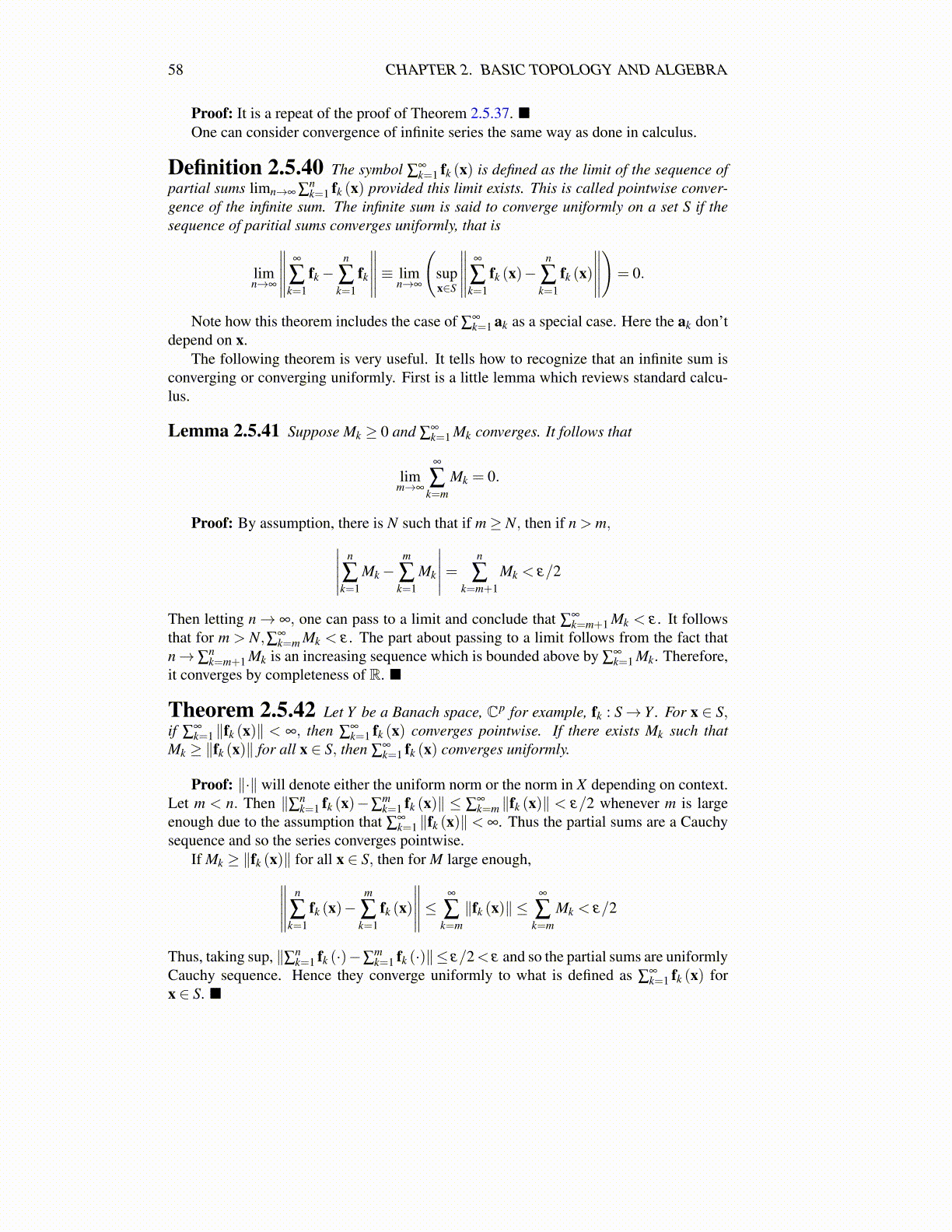
58 CHAPTER 2. BASIC TOPOLOGY AND ALGEBRA
Proof: It is a repeat of the proof of Theorem 2.5.37. ■One can consider convergence of infinite series the same way as done in calculus.
Definition 2.5.40 The symbol ∑∞k=1 fk (x) is defined as the limit of the sequence of
partial sums limn→∞ ∑nk=1 fk (x) provided this limit exists. This is called pointwise conver-
gence of the infinite sum. The infinite sum is said to converge uniformly on a set S if thesequence of paritial sums converges uniformly, that is
limn→∞
∥∥∥∥∥ ∞
∑k=1
fk−n
∑k=1
fk
∥∥∥∥∥≡ limn→∞
(supx∈S
∥∥∥∥∥ ∞
∑k=1
fk (x)−n
∑k=1
fk (x)
∥∥∥∥∥)
= 0.
Note how this theorem includes the case of ∑∞k=1 ak as a special case. Here the ak don’t
depend on x.The following theorem is very useful. It tells how to recognize that an infinite sum is
converging or converging uniformly. First is a little lemma which reviews standard calcu-lus.
Lemma 2.5.41 Suppose Mk ≥ 0 and ∑∞k=1 Mk converges. It follows that
limm→∞
∞
∑k=m
Mk = 0.
Proof: By assumption, there is N such that if m≥ N, then if n > m,∣∣∣∣∣ n
∑k=1
Mk−m
∑k=1
Mk
∣∣∣∣∣= n
∑k=m+1
Mk < ε/2
Then letting n→ ∞, one can pass to a limit and conclude that ∑∞k=m+1 Mk < ε . It follows
that for m > N,∑∞k=m Mk < ε . The part about passing to a limit follows from the fact that
n→∑nk=m+1 Mk is an increasing sequence which is bounded above by ∑
∞k=1 Mk. Therefore,
it converges by completeness of R. ■
Theorem 2.5.42 Let Y be a Banach space, Cp for example, fk : S→ Y . For x ∈ S,if ∑
∞k=1 ∥fk (x)∥ < ∞, then ∑
∞k=1 fk (x) converges pointwise. If there exists Mk such that
Mk ≥ ∥fk (x)∥ for all x ∈ S, then ∑∞k=1 fk (x) converges uniformly.
Proof: ∥·∥ will denote either the uniform norm or the norm in X depending on context.Let m < n. Then ∥∑n
k=1 fk (x)−∑mk=1 fk (x)∥ ≤ ∑
∞k=m ∥fk (x)∥ < ε/2 whenever m is large
enough due to the assumption that ∑∞k=1 ∥fk (x)∥ < ∞. Thus the partial sums are a Cauchy
sequence and so the series converges pointwise.If Mk ≥ ∥fk (x)∥ for all x ∈ S, then for M large enough,∥∥∥∥∥ n
∑k=1
fk (x)−m
∑k=1
fk (x)
∥∥∥∥∥≤ ∞
∑k=m∥fk (x)∥ ≤
∞
∑k=m
Mk < ε/2
Thus, taking sup, ∥∑nk=1 fk (·)−∑
mk=1 fk (·)∥≤ ε/2< ε and so the partial sums are uniformly
Cauchy sequence. Hence they converge uniformly to what is defined as ∑∞k=1 fk (x) for
x ∈ S. ■